A Validity Analysis of Text-to-Image Generative Artificial Intelligence Models for Craniofacial Anatomy Illustration
Abstract
1. Introduction
1.1. Anatomical Illustrations: Cornerstones of Medical Education
1.2. Traditional Methods: Hurdles and Constraints
1.3. GAI: A Promising Frontier
2. Literature Review
2.1. Understanding AI Image Generation Techniques
2.2. Applications in Medical Illustration
3. Materials and Methods
3.1. GAI Models Evaluated
3.2. Image Generation Process
3.2.1. Prompt Generation
“A high-definition [illustration/photograph] of the [layer: bone/muscle etc.] of the human [face/head], [frontal/lateral/superior/inferior/mid-sagittal] view, with a clear depiction of [features]. The background is simple and white. Style: [Oil painting in a medical illustration/ Photograph taken from a professional camera]”
3.2.2. Ethical Approval
3.3. Evaluation Criteria
- Anatomical detail (D): This criterion assessed the accuracy and completeness of the anatomical features depicted, including proportions, layers, angles, and views. This included accurate proportions of anatomical structures, clear delineation of the requested anatomical layer (e.g., nerves being distinguishable from surrounding structures, muscles having accurate origins/insertions), and appropriate viewing angles matching the specified prompts. Reviewers were asked to specifically assess the correctness of anatomical relationships and the presence of key anatomical landmarks.
- Aesthetic quality (A): This criterion evaluated the visual appeal of the images, considering factors such as color, lighting, and shadows, in comparison to currently available publications while adhering to the requested artistic style specified in the prompt. Reviewers were asked to consider if the color palette and lighting were appropriate for medical illustrations, and if shadows enhanced or detracted from anatomical clarity
- Usability (U): This criterion assessed the suitability of the images for use in scientific literature compared to currently available resources (i.e., is the current image usable in research papers, publications, books, or other educational materials). Reviewers were instructed to consider if the images could be used without further modification in a textbook or research article.
- Cost-effectiveness (C): This criterion evaluated the potential cost savings of using AI-generated images compared to traditional illustration methods, based on the estimated number of potential revisions and the time and effort a professional artist would need to refine the AI-generated image to meet traditional standards. Reviewers were instructed to estimate the number of potential revisions and the time and effort required for a professional artist to achieve traditional standards.
3.4. Evaluation Process
3.5. Craniofacial Proportion Index Calculation
3.5.1. Frontal View Analysis
- Facial Index: calculated from facial height and bizygomatic breadth, providing insights into facial proportions [37].
- Upper Facial Index: calculated from upper face height and bizygomatic breadth, providing insights into vertical facial proportions.
3.5.2. Lateral View Analysis
- Facial Convexity Angle: measured to assess facial profile balance and protrusion [38].
3.5.3. Superior View Analysis
- Cephalic Index: calculated from biparietal and occipitofrontal distances, providing insights into head shape [39].
4. Results
4.1. Subgroup Analysis of AI Model Performance Across Anatomical Layers
- Surface Anatomy: Midjourney v6.0 performed best in anatomical detail with a score of 3.78, while DALL-E 3 was strongest in aesthetic quality with a score of 3.98 and cost-effectiveness with a score of 3.51 (Figure 5a).
- Bones: Midjourney v6.0 outperformed other models in all criteria, with a score of 3.28 for anatomical detail, 4.27 for aesthetic quality, 2.99 for usability, and 2.98 for cost-effectiveness (Figure 5b).
- Blood Vessels and Nerves: DALL-E 3 outperformed other models, including anatomical detail (2.78), aesthetic quality (3.48), usability (2.4), and cost-effectiveness (2.43) but the generated images were still not suitable for educational purposes due to anatomical inaccuracies (Figure 5c,e).
- Muscles: DALL-E 3 was better in anatomical detail with a score of 2.78 and usability with a score of 2.40, while Midjourney v6.0 was stronger in aesthetic quality with a score of 3.83 (Figure 5d).
4.2. Inter-Rater Reliability Analysis
4.3. Results of Cephalometric Analysis
5. Discussion
5.1. Performance Evaluation and Comparative Analysis
5.2. The Role of AI in Anatomy Education
5.3. Technical and Methodological Challenges
- Abstract Depictions: some images presented overly simplified or stylized representations of anatomical structures, lacking the necessary detail for medical education;
- Mixing of Layers: the models often juxtaposed anatomical layers, such as including flesh and skin on the nose in lateral views of the skull bones or depicting superficial muscles alongside deep structures;
- Abnormal Muscle Arrangement, Origins, and Insertions: muscle anatomy was frequently inaccurate, with errors in muscle shape, arrangement, and the depiction of origins and insertions;
- Challenge in Generating Superior/Inferior Views: the models struggled to accurately generate superior and inferior views, often resulting in distorted or incomplete representations;
- Tree Branching of Nerves and Arteries: the depiction of blood vessels and nerves often lacked a clear course and distribution, sometimes appearing to emerge from the body and project into the surrounding area like tree branches, rather than following realistic anatomical pathways;
- Extra Foramina and Abnormal Sutures: skeletal representations often included extra foramina or depicted abnormal suture lines, deviating from accurate anatomical structure;
- Shadowing: in some instances, shadowing was unrealistic or obscured anatomical details, hindering clarity;
- Abnormal Proportions: images from Stable Diffusion 2.0 exhibited abnormal proportions in the depicted anatomical structures;
- Challenge in Generating Midsagittal Section Views: the models encountered difficulties in generating accurate midsagittal section views, with structures often appearing incomplete or misrepresented;
- Labeling Errors: when present, annotations and labels were frequently illegible or nonsensical in line with previous research [45].
5.4. Ethical Considerations
5.5. Future Directions
6. Conclusions
Supplementary Materials
Author Contributions
Funding
Institutional Review Board Statement
Informed Consent Statement
Data Availability Statement
Acknowledgments
Conflicts of Interest
References
- Rubalcava, N.S.; Gadepalli, S.K. From Ancient Texts to Digital Imagery: A Brief History on the Evolution of Anatomic Illustrations. Am. Surg. 2021, 87, 1259–1266. [Google Scholar] [CrossRef]
- Chabrier, R.; Janke, C. The comeback of hand drawing in modern life sciences. Nat. Rev. Mol. Cell Biol. 2018, 19, 137–138. [Google Scholar] [CrossRef]
- Won, H.S.; Yang, M.; Kim, Y.D. Necessity of professional medical illustration for increasing the value of the journal. Korean J. Pain. 2024, 37, 84–86. [Google Scholar] [CrossRef] [PubMed]
- Becoming a Medical Illustrator: A Comprehensive Guide|Huzzle. 2024. Available online: https://www.huzzle.app/blog/becoming-a-medical-illustrator-a-comprehensive-guide (accessed on 29 May 2024).
- How to Become a Medical Illustrator (Skills & Steps). 2023. Available online: https://illustratorhow.com/become-medical-illustrator (accessed on 29 May 2024).
- Learn About Medical Illustration. 2024. Available online: https://ami.org/medical-illustration/learn-about-medical-illustration (accessed on 2 November 2024).
- Generative AI Has an Intellectual Property Problem. 2023. Available online: https://hbr.org/2023/04/generative-ai-has-an-intellectual-property-problem (accessed on 2 November 2024).
- Medical Artist Resource. Available online: http://medical-artist.org/medical-illustration-mediums (accessed on 2 November 2024).
- Radzi, S.; Chandrasekaran, R.; Peh, Z.K.; Rajalingam, P.; Yeong, W.Y.; Mogali, S.R. Students’ learning experiences of three-dimensional printed models and plastinated specimens: A qualitative analysis. BMC Med. Educ. 2022, 22, 695. [Google Scholar] [CrossRef]
- Louie, P.; Wilkes, R. Representations of race and skin tone in medical textbook imagery. Soc. Sci. Med. 2018, 202, 38–42. [Google Scholar] [CrossRef] [PubMed]
- Beresheim, A.; Zepeda, D.; Pharel, M.; Soy, T.; Wilson, A.B.; Ferrigno, C. Anatomy’s missing faces: An assessment of representation gaps in atlas and textbook imagery. Anat. Sci. Educ. 2024, 17, 1055–1070. [Google Scholar]
- Chesher, C. The emergence of autolography: The ‘magical’ invocation of images from text through AI. Media Int. Aust. 2023, 189, 57–73. [Google Scholar] [CrossRef]
- Noel, G. Evaluating AI-powered text-to-image generators for anatomical illustration: A comparative study. Anat. Sci. Educ. 2023, 17, 979–983. [Google Scholar] [CrossRef]
- Totlis, T.; Natsis, K.; Filos, D.; Ediaroglou, V.; Mantzou, N.; Duparc, F.; Piagkou, M. The potential role of ChatGPT and artificial intelligence in anatomy education: A conversation with ChatGPT. Surg. Radiol. Anat. 2023, 45, 1321–1329. [Google Scholar] [CrossRef]
- Leng, L. Challenge, integration, and change: ChatGPT and future anatomical education. Med. Educ. Online 2024, 29, 2304973. [Google Scholar] [CrossRef]
- Mogali, S.R. Initial impressions of ChatGPT for anatomy education. Anat. Sci. Educ. 2024, 17, 444–447. [Google Scholar] [CrossRef] [PubMed]
- Liu, Z.; Smith, P.; Lautin, A.; Zhou, J.; Yoo, M.; Sullivan, M.; Li, H.; Deyer, L.; Zhou, A.; Yang, A. RadImageGAN–A Multi-Modal Dataset-Scale Generative AI for Medical Imaging; Springer: Berlin/Heidelberg, Germany, 2024; pp. 173–185. [Google Scholar]
- Ajmera, P.; Nischal, N.; Ariyaratne, S.; Botchu, B.; Bhamidipaty, K.D.P.; Iyengar, K.P.; Ajmera, S.R.; Jenko, N.; Botchu, R. Validity of ChatGPT-generated musculoskeletal images. Skelet. Radiol. 2024, 53, 1583–1593. [Google Scholar] [CrossRef]
- Goodfellow, I.J.; Pouget-Abadie, J.; Mirza, M.; Xu, B.; Warde-Farley, D.; Ozair, S.; Courville, A.; Bengio, Y. Generative Adversarial Networks. arXiv 2014, arXiv:1406.2661. [Google Scholar] [CrossRef]
- Ho, J.; Jain, A.; Abbeel, P. Denoising Diffusion Probabilistic Models. arXiv 2020, arXiv:2006.11239. [Google Scholar] [CrossRef]
- Ronneberger, O.; Fischer, P.; Brox, T. U-Net: Convolutional Networks for Biomedical Image Segmentation; Springer International Publishing: Berlin/Heidelberg, Germany, 2015; pp. 234–241. [Google Scholar]
- Williams, M.C.; Williams, S.E.; Newby, D.E. Artificial Intelligence–based Text-to-Image Generation of Cardiac CT. Radiol. Cardiothorac. Imaging 2023, 5, e220297. [Google Scholar] [CrossRef] [PubMed]
- Buzzaccarini, G.; Degliuomini, R.S.; Borin, M.; Fidanza, A.; Salmeri, N.; Schiraldi, L.; Di Summa, P.G.; Vercesi, F.; Vanni, V.S.; Candiani, M.; et al. The Promise and Pitfalls of AI-Generated Anatomical Images: Evaluating Midjourney for Aesthetic Surgery Applications. Aesthetic Plast. Surg. 2024, 48, 1874–1883. [Google Scholar] [CrossRef] [PubMed]
- Kumar, A.; Burr, P.; Young, T.M. Using AI Text-to-Image Generation to Create Novel Illustrations for Medical Education: Current Limitations as Illustrated by Hypothyroidism and Horner Syndrome. JMIR Med. Educ. 2024, 10, e52155. [Google Scholar] [CrossRef]
- Kim, J.; Um, R.; Lee, J.; Ajilore, O. Generative AI can fabricate advanced scientific visualizations: Ethical implications and strategic mitigation framework. AI Ethics 2024, 1–13. [Google Scholar] [CrossRef]
- Adams, L.C.; Busch, F.; Truhn, D.; Makowski, M.R.; Aerts, H.; Bressem, K.K. What Does DALL-E 2 Know About Radiology? J. Med. Internet Res. 2023, 25, e43110. [Google Scholar] [CrossRef]
- Wong, C. AI-generated images and video are here: How could they shape research? Nature 2024. [Google Scholar] [CrossRef]
- Midjourney Terms of Service. 2024. Available online: https://docs.midjourney.com/docs/terms-of-service (accessed on 10 May 2024).
- Zhu, L.; Mou, W.; Wu, K.; Zhang, J.; Luo, P. Can DALL-E 3 Reliably Generate 12-Lead ECGs and Teaching Illustrations? Cureus 2024, 16, e52748. [Google Scholar] [CrossRef]
- DALL·E 3. 2024. Available online: https://openai.com/index/dall-e-3 (accessed on 10 May 2024).
- Gemini-Google DeepMind. 2024. Available online: https://deepmind.google/technologies/gemini/#introduction (accessed on 10 May 2024).
- Stabilityai/Stable-Diffusion-2 · Hugging Face. 2024. Available online: https://huggingface.co/stabilityai/stable-diffusion-2 (accessed on 10 May 2024).
- Porter, J.P. The average African American male face: An anthropometric analysis. Arch. Facial Plast. Surg. 2004, 6, 78–81. [Google Scholar] [CrossRef] [PubMed]
- Moshkelgosha, V.; Fathinejad, S.; Pakizeh, Z.; Shamsa, M.; Golkari, A. Photographic Facial Soft Tissue Analysis by Means of Linear and Angular Measurements in an Adolescent Persian Population. Open Dent. J. 2015, 9, 346–356. [Google Scholar] [CrossRef] [PubMed]
- Kaya, K.S.; Türk, B.; Cankaya, M.; Seyhun, N.; Coşkun, B.U. Assessment of facial analysis measurements by golden proportion. Braz. J. Otorhinolaryngol. 2019, 85, 494–501. [Google Scholar] [CrossRef] [PubMed]
- Daniel, I.; Taub, J.M.S.J.; Jacobs, J.S. Anthropometry, cephalometry, and orthognathic surgery. Plast. Surg. Key 2016, 2, 360. [Google Scholar]
- Morosini, I.d.A.C.; Peron, A.P.L.M.; Correia, K.R.; Moresca, R. Study of face pleasantness using facial analysis in standardized frontal photographs. Dent. Press. J. Orthod. 2012, 17, 24–34. [Google Scholar] [CrossRef]
- Meneghini, F.; Biondi, P. Clinical Facial Analysis: Elements, Principles, and Techniques; Springer Science & Business Media: Berlin, Germany, 2012. [Google Scholar]
- Milos Brandenberg, D.; González Espinoza, D.; Valenzuela-Fuenzalida, J.; Nova-Baeza, P.; Orellana-Donoso, M. Anatomical Characteristics, Relations, and Clinical Considerations of the Facial Index and Cephalic Index in Young Chileans Aged Between 18 and 21 Years. Int. J. Morphol. 2023, 41, 1720–1726. [Google Scholar]
- Samuel, S. Black Nazis? A Woman Pope? That’s Just the Start of Google’s AI Problem. Vox. 2024. Available online: https://www.vox.com/future-perfect/2024/2/28/24083814/google-gemini-ai-bias-ethics (accessed on 10 May 2024).
- Vaira, L.A.; Lechien, J.R.; Abbate, V.; Allevi, F.; Audino, G.; Beltramini, G.A.; Bergonzani, M.; Bolzoni, A.; Committeri, U.; Crimi, S.; et al. Accuracy of ChatGPT-Generated Information on Head and Neck and Oromaxillofacial Surgery: A Multicenter Collaborative Analysis. Otolaryngol.-Head Neck Surg. 2024, 170, 1492–1503. [Google Scholar] [CrossRef]
- Kwon, D.Y.; Wang, A.; Mejia, M.R.; Saturno, M.P.; Oleru, O.; Seyidova, N.; Taub, P.J. Adherence of a Large Language Model to Clinical Guidelines for Craniofacial Plastic and Reconstructive Surgeries. Ann. Plast. Surg. 2024, 92, 261–262. [Google Scholar] [CrossRef]
- Ismail, A.F.R. Medical Animation in Educational Virtual Environments and Its Effect on Medical Reality Perception. Online J. Commun. Media–Oct. 2018, 4, 24. [Google Scholar]
- Chheang, V.; Sharmin, S.; Márquez-Hernández, R.; Patel, M.; Rajasekaran, D.; Caulfield, G.; Kiafar, B.; Li, J.; Kullu, P.; Barmaki, R.L. Towards anatomy education with generative AI-based virtual assistants in immersive virtual reality environments. In Proceedings of the 2024 IEEE International Conference on Artificial Intelligence and eXtended and Virtual Reality (AIxVR), Los Angeles, CA, USA, 17–19 January 2024; IEEE: Piscataway, NJ, USA, 2024; pp. 21–30. [Google Scholar]
- Borji, A. Qualitative Failures of Image Generation Models and Their Application in Detecting Deepfakes. arXiv 2023. [Google Scholar] [CrossRef]
- Chayka, K. The Uncanny Failure of A.I.-Generated Hands. New Yorker 2023. Available online: https://www.newyorker.com/culture/rabbit-holes/the-uncanny-failures-of-ai-generated-hands (accessed on 10 May 2024).
- Ali, R.; Tang, O.Y.; Connolly, I.D.; Abdulrazeq, H.F.; Mirza, F.N.; Lim, R.K.; Johnston, B.R.; Groff, M.W.; Williamson, T.; Svokos, K.; et al. Demographic Representation in 3 Leading Artificial Intelligence Text-to-Image Generators. JAMA Surg. 2024, 159, 87–95. [Google Scholar] [CrossRef]
- Pressman, S.M.; Borna, S.; Gomez-Cabello, C.A.; Haider, S.A.; Haider, C.; Forte, A.J. AI and Ethics: A Systematic Review of the Ethical Considerations of Large Language Model Use in Surgery Research. Healthcare 2024, 12, 825. [Google Scholar] [CrossRef]
- Montreal AI Ethics Institute. Unstable Diffusion: Ethical Challenges and Some Ways Forward. 2022. Available online: https://montrealethics.ai/unstable-diffusion-ethical-challenges-and-some-ways-forward (accessed on 29 May 2024).
- Li, H.; Moon, J.T.; Purkayastha, S.; Celi, L.A.; Trivedi, H.; Gichoya, J.W. Ethics of large language models in medicine and medical research. Lancet Digit. Health 2023, 5, e333–e335. [Google Scholar] [CrossRef] [PubMed]
- O’Malley, A.; Veenhuizen, M.; Ahmed, A. Ensuring Appropriate Representation in Artificial Intelligence–Generated Medical Imagery: Protocol for a Methodological Approach to Address Skin Tone Bias. JMIR AI 2024, 3, e58275. [Google Scholar]
- Haider, S.A.; Borna, S.; Gomez-Cabello, C.A.; Pressman, S.M.; Haider, C.R.; Forte, A.J. The Algorithmic Divide: A Systematic Review on AI-Driven Racial Disparities in Healthcare. J. Racial Ethn. Health Disparities 2024, 1–30. [Google Scholar] [CrossRef]
- Roose, K. AI-Generated Art Won a Prize. Artists Aren’t Happy. The New York Times 2022. Available online: https://www.nytimes.com/2022/09/02/technology/ai-artificial-intelligence-artists.html (accessed on 24 February 2025).
- Ma, L.; Han, J.; Wang, Z.; Zhang, D. CephGPT-4: An Interactive Multimodal Cephalometric Measurement and Diagnostic System with Visual Large Language Model. arXiv 2023, arXiv:2307.0751. [Google Scholar] [CrossRef]
- Google Cloud Blog. A developer’s guide to Imagen 3 on Vertex AI. 2024. Available online: https://cloud.google.com/blog/products/ai-machine-learning/a-developers-guide-to-imagen-3-on-vertex-ai (accessed on 2 November 2024).
- Lin, C.-H.; Gao, J.; Tang, L.; Takikawa, T.; Zeng, X.; Huang, X.; Kreis, K.; Fidler, S.; Liu, M.-Y.; Lin, T.-Y. Magic3D: High-Resolution Text-to-3D Content Creation. arXiv 2022, arXiv:2211.10440. [Google Scholar] [CrossRef]
- Alpha3d. Alpha 3d-Transform Text and 2D Images into 3D Assets with Generative AI for Free. 2023. Available online: https://www.alpha3d.io/ (accessed on 24 February 2025).
- Liu, Y.; Zhang, K.; Li, Y.; Yan, Z.; Gao, C.; Chen, R.; Yuan, Z.; Huang, Y.; Sun, H.; Gao, J.; et al. Sora: A Review on Background, Technology, Limitations, and Opportunities of Large Vision Models. arXiv 2024, arXiv:2402.17177. [Google Scholar] [CrossRef]
- Pavlichenko, N.; Ustalov, D. Best Prompts for Text-to-Image Models and How to Find Them. In Proceedings of the of the 46th International ACM SIGIR Conference on Research and Development in Information Retrieval, Taipei, Taiwan, 23–27 July 2023. [Google Scholar] [CrossRef]
- Lee, K.; Liu, H.; Ryu, M.; Watkins, O.; Du, Y.; Boutilier, C.; Abbeel, P.; Ghavamzadeh, M.; Gu, S.S. Aligning Text-to-Image Models using Human Feedback. arXiv 2023, arXiv:2302.12192. [Google Scholar] [CrossRef]
- Goceri, E. Medical image data augmentation: Techniques, comparisons and interpretations. Artif. Intell. Rev. 2023, 56, 12561–12605. [Google Scholar] [CrossRef]
- Chen, W.; Hu, H.; Saharia, C.; Cohen, W.W. Re-Imagen: Retrieval-Augmented Text-to-Image Generator. arXiv 2022, arXiv:2209.14491. [Google Scholar] [CrossRef]
- Frolov, S.; Hinz, T.; Raue, F.; Hees, J.; Dengel, A. Adversarial Text-to-Image Synthesis: A Review. Neural Netw. 2021, 144, 187–209. [Google Scholar] [CrossRef]
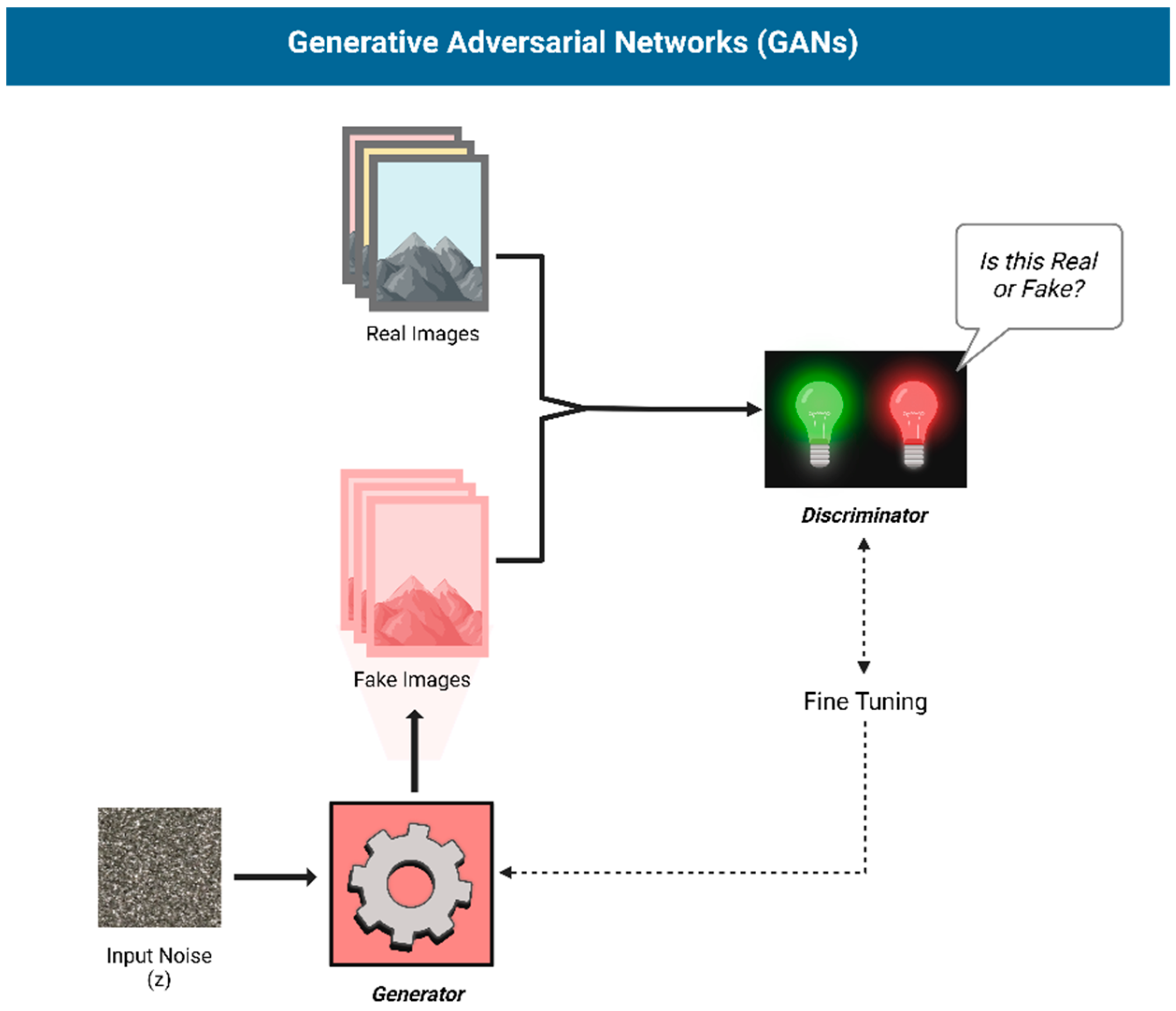

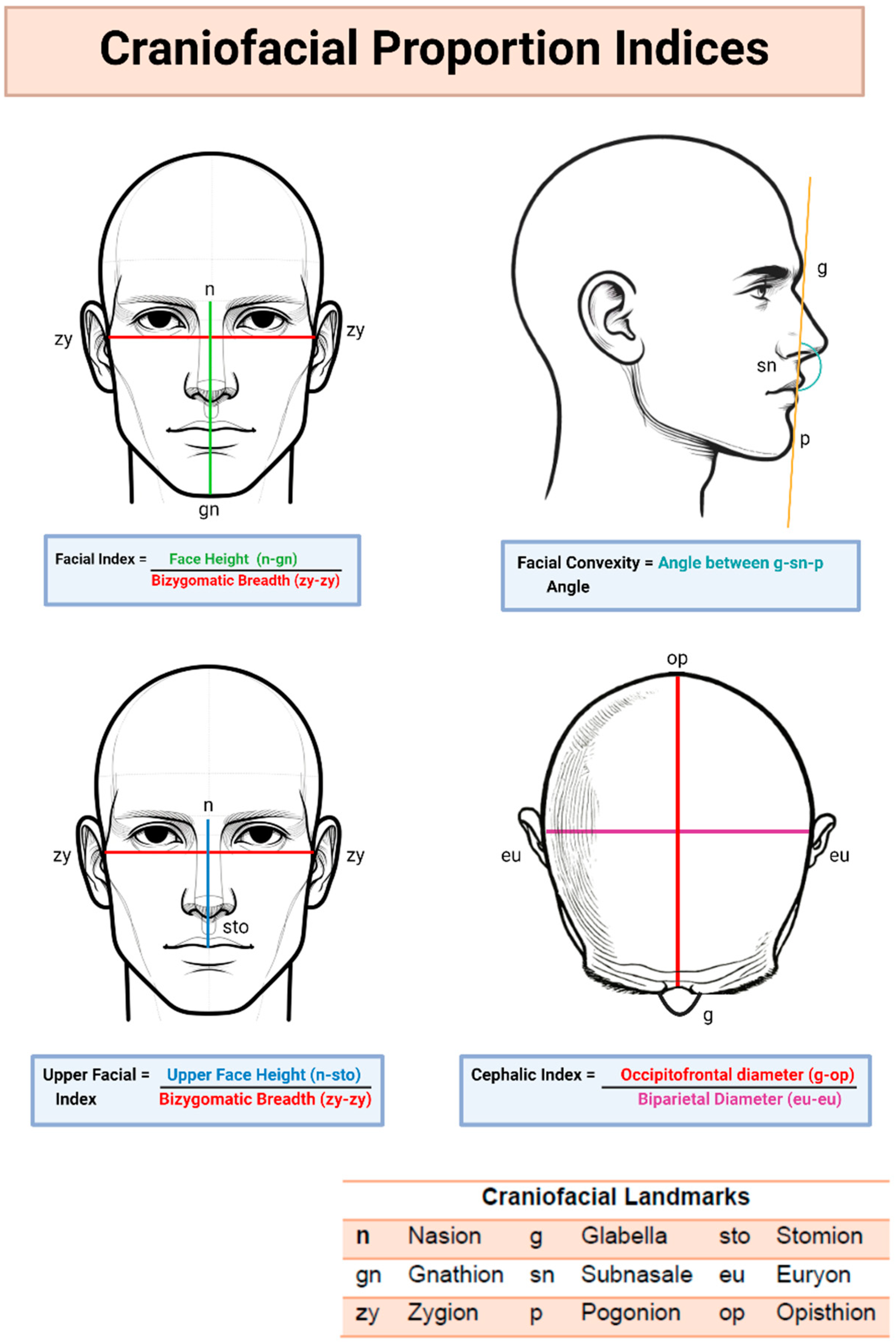
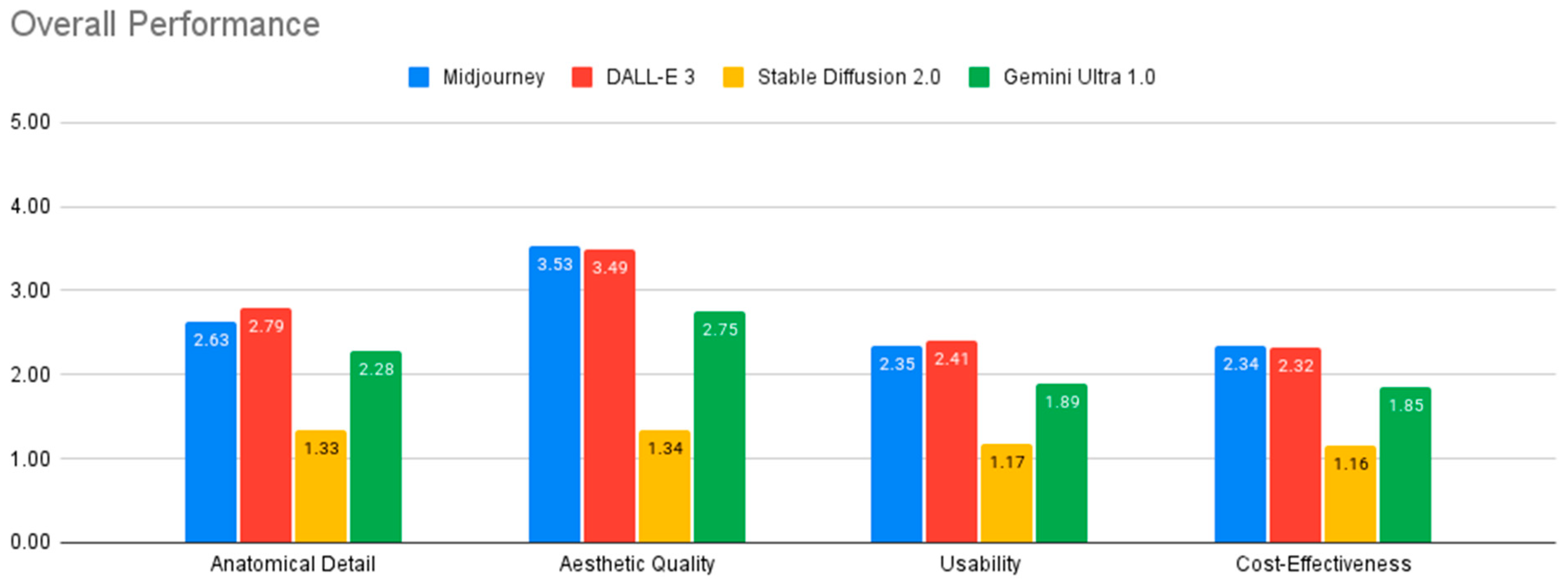
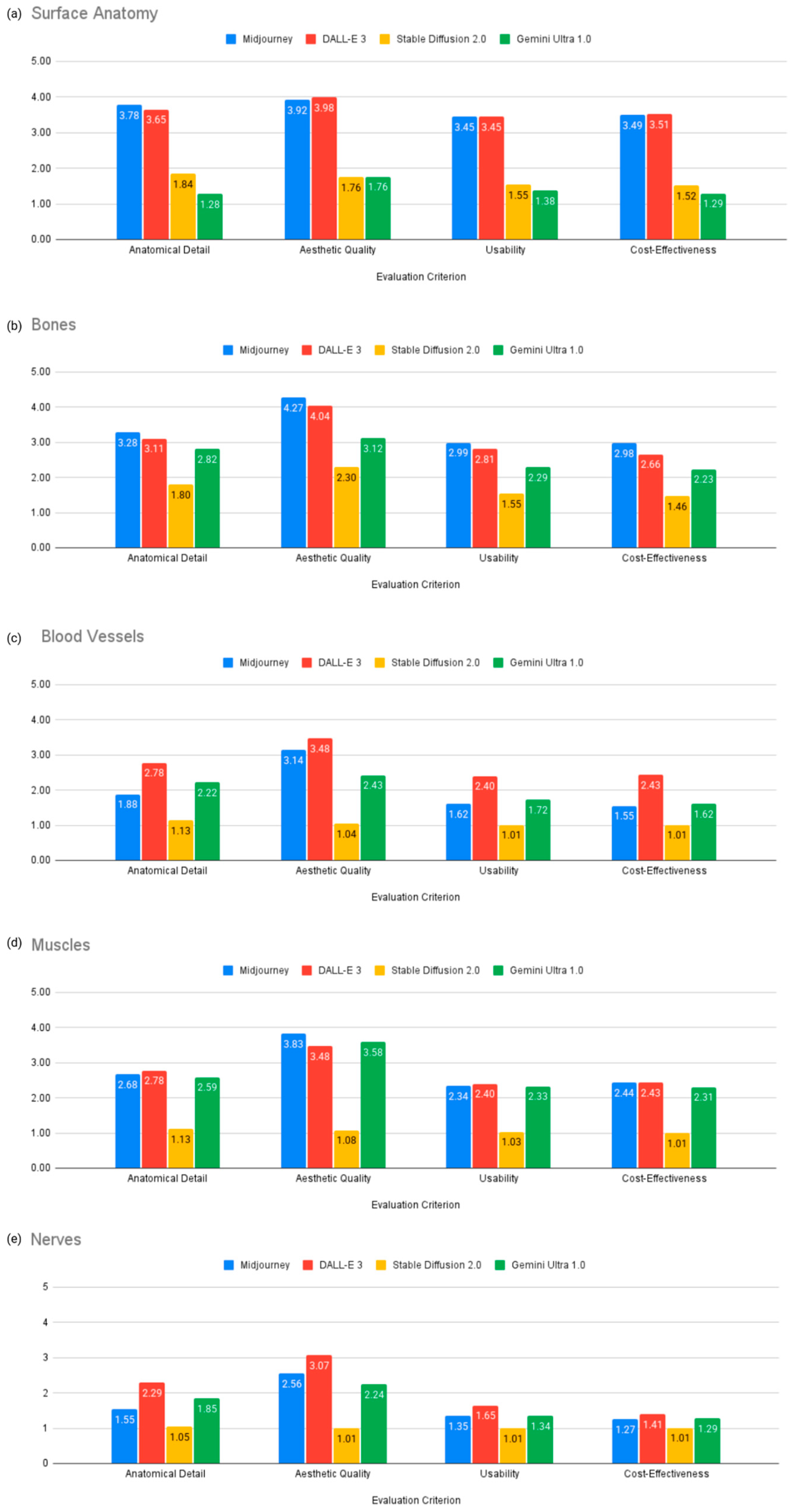
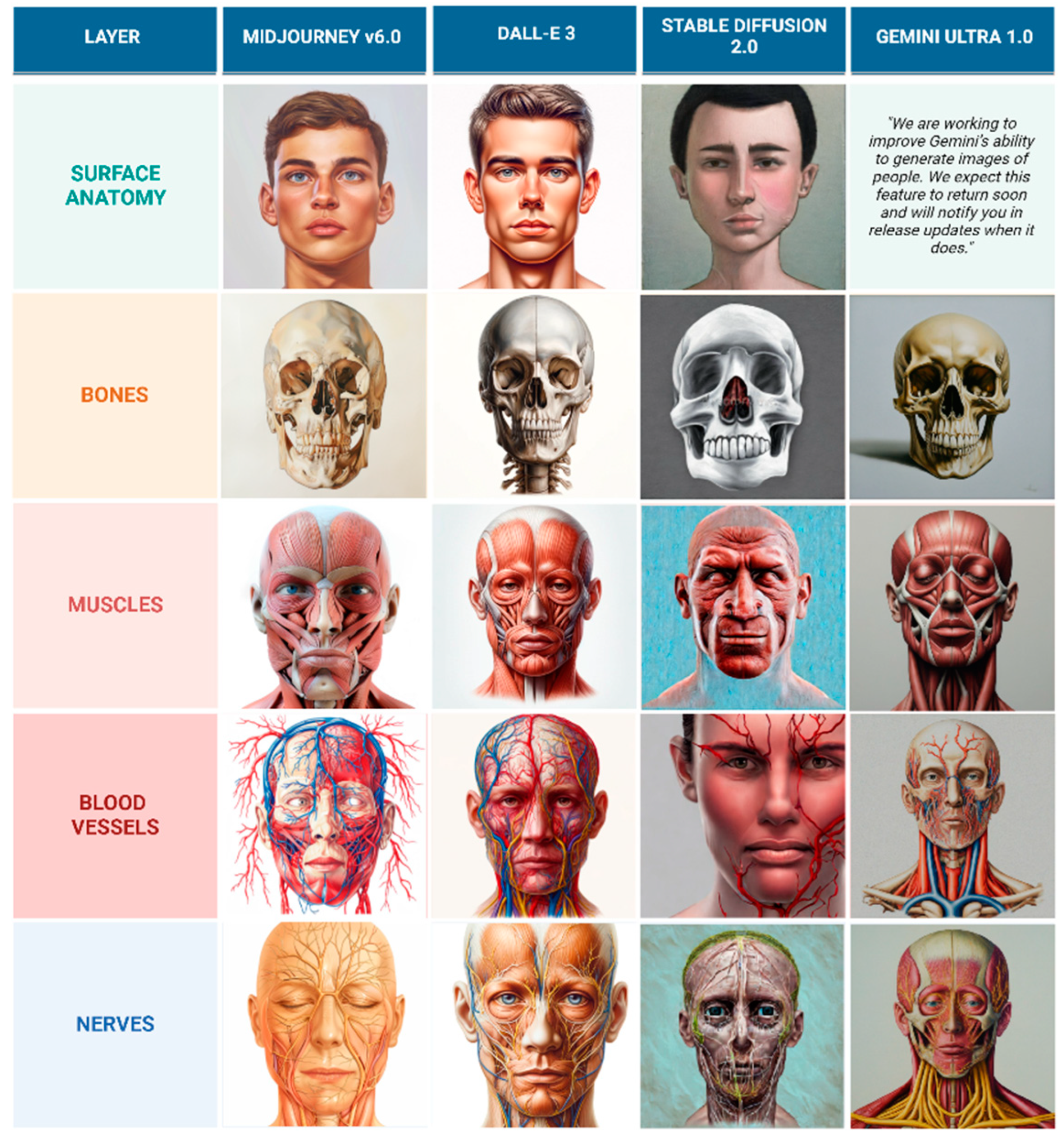
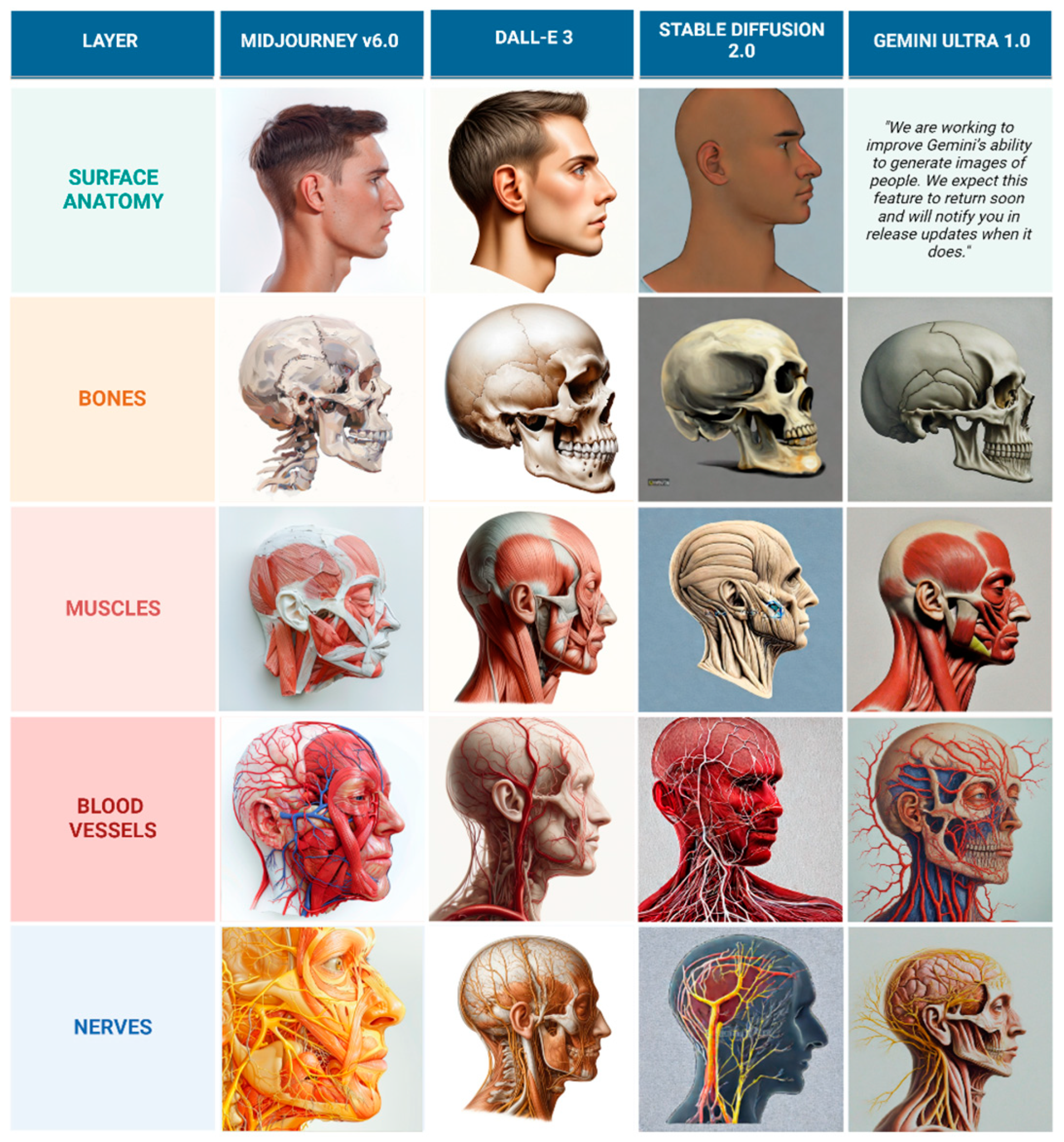


| MEAN ± SD | Detail | Aesthetic | Usability | Cost Effectiveness |
|---|---|---|---|---|
| Midjourney v6.0 | 2.63 ± 1.24 | 3.53 ± 1.37 | 2.35 ± 1.27 | 2.34 ± 1.32 |
| DALL-E 3 | 2.79 ± 1.15 | 3.49 ± 1.16 | 2.41 ± 1.19 | 2.32 ± 1.25 |
| Stable Diffusion 2.0 | 1.33 ± 0.47 | 1.34 ± 0.65 | 1.17 ± 0.32 | 1.16 ± 0.33 |
| Gemini Ultra | 2.28 ± 1.05 | 2.75 ± 1.16 | 1.89 ± 1.03 | 1.85 ± 1.04 |
| MEDIAN | Detail | Aesthetic | Usability | Cost-Effectiveness |
| Midjourney v6.0 | 3 | 4 | 2 | 2 |
| DALL-E 3 | 3 | 4 | 2 | 2 |
| Stable Diffusion 2.0 | 1 | 1 | 1 | 1 |
| Gemini Ultra | 2 | 3 | 1 | 1 |
| MODE | Detail | Aesthetic | Usability | Cost-Effectiveness |
| Midjourney v6.0 | 1 | 1 | 1 | 4 |
| DALL-E 3 | 1 | 1 | 1 | 1 |
| Stable Diffusion 2.0 | 1 | 1 | 1 | 1 |
| Gemini Ultra | 1 | 1 | 2 | 3 |
| Layer | Evaluation Criterion | Midjourney v6.0 | DALL-E 3 | Stable Diffusion 2.0 | Gemini Ultra 1.0 |
|---|---|---|---|---|---|
| Surface Anatomy | Anatomical Detail | 3.78 | 3.65 | 1.84 | 1.28 |
| Aesthetic Quality | 3.92 | 3.98 | 1.76 | 1.76 | |
| Usability | 3.45 | 3.45 | 1.55 | 1.38 | |
| Cost-Effectiveness | 3.49 | 3.51 | 1.52 | 1.29 | |
| Bones | Anatomical Detail | 3.28 | 3.11 | 1.80 | 2.82 |
| Aesthetic Quality | 4.27 | 4.04 | 2.30 | 3.12 | |
| Usability | 2.99 | 2.81 | 1.55 | 2.29 | |
| Cost-Effectiveness | 2.98 | 2.66 | 1.46 | 2.23 | |
| Muscles | Anatomical Detail | 2.68 | 2.78 | 1.13 | 2.59 |
| Aesthetic Quality | 3.83 | 3.48 | 1.08 | 3.58 | |
| Usability | 2.34 | 2.40 | 1.03 | 2.33 | |
| Cost-Effectiveness | 2.44 | 2.43 | 1.01 | 2.31 | |
| Blood Vessels | Anatomical Detail | 1.88 | 2.78 | 1.13 | 2.22 |
| Aesthetic Quality | 3.14 | 3.48 | 1.04 | 2.43 | |
| Usability | 1.62 | 2.40 | 1.01 | 1.72 | |
| Cost-Effectiveness | 1.55 | 2.43 | 1.01 | 1.62 | |
| Nerves | Anatomical Detail | 1.55 | 2.29 | 1.05 | 1.85 |
| Aesthetic Quality | 2.56 | 3.07 | 1.01 | 2.24 | |
| Usability | 1.35 | 1.65 | 1.01 | 1.34 | |
| Cost-Effectiveness | 1.27 | 1.41 | 1.01 | 1.29 |
| Level of Analysis | AI Model/Metric | ICC | 95% Confidence Interval |
|---|---|---|---|
| Overall Agreement | All Models/Metrics | 0.858 | [0.851, 0.866] |
| Agreement by Model | Midjourney v6.0 | 0.825 | [0.806, 0.843] |
| DALL-E 3 | 0.805 | [0.784, 0.825] | |
| Stable Diffusion 2.0 | 0.707 | [0.675, 0.737] | |
| Gemini Ultra 1.0 | 0.776 | [0.748, 0.802] | |
| Agreement by Metric | Anatomical Detail | 0.852 | [0.836, 0.868] |
| Aesthetic Quality | 0.852 | [0.835, 0.867] | |
| Usability | 0.838 | [0.820, 0.855] | |
| Cost-Effectiveness | 0.836 | [0.817, 0.853] |
| Facial Index | Upper Facial Index | Facial Convexity Angle | Cephalic Index | |
|---|---|---|---|---|
| Reference Image | 86.22 | 48.40 | 170.96 | 80.00 |
| Midjourney v6.0 | 86.63 | 47.65 | 173.40 | 84.33 |
| DALL E-3 | 90.38 | 47.77 | 171.00 | 80.86 |
| Stable Diffusion 2.0 | 93.37 | 52.96 | 176.10 | 75.89 |
| Gemini Ultra 1.0 | N/A | N/A | N/A | 90.57 |
Disclaimer/Publisher’s Note: The statements, opinions and data contained in all publications are solely those of the individual author(s) and contributor(s) and not of MDPI and/or the editor(s). MDPI and/or the editor(s) disclaim responsibility for any injury to people or property resulting from any ideas, methods, instructions or products referred to in the content. |
© 2025 by the authors. Licensee MDPI, Basel, Switzerland. This article is an open access article distributed under the terms and conditions of the Creative Commons Attribution (CC BY) license (https://creativecommons.org/licenses/by/4.0/).
Share and Cite
Haider, S.A.; Prabha, S.; Gomez-Cabello, C.A.; Borna, S.; Pressman, S.M.; Genovese, A.; Trabilsy, M.; Galvao, A.; Aziz, K.T.; Murray, P.M.; et al. A Validity Analysis of Text-to-Image Generative Artificial Intelligence Models for Craniofacial Anatomy Illustration. J. Clin. Med. 2025, 14, 2136. https://doi.org/10.3390/jcm14072136
Haider SA, Prabha S, Gomez-Cabello CA, Borna S, Pressman SM, Genovese A, Trabilsy M, Galvao A, Aziz KT, Murray PM, et al. A Validity Analysis of Text-to-Image Generative Artificial Intelligence Models for Craniofacial Anatomy Illustration. Journal of Clinical Medicine. 2025; 14(7):2136. https://doi.org/10.3390/jcm14072136
Chicago/Turabian StyleHaider, Syed Ali, Srinivasagam Prabha, Cesar A. Gomez-Cabello, Sahar Borna, Sophia M. Pressman, Ariana Genovese, Maissa Trabilsy, Andrea Galvao, Keith T. Aziz, Peter M. Murray, and et al. 2025. "A Validity Analysis of Text-to-Image Generative Artificial Intelligence Models for Craniofacial Anatomy Illustration" Journal of Clinical Medicine 14, no. 7: 2136. https://doi.org/10.3390/jcm14072136
APA StyleHaider, S. A., Prabha, S., Gomez-Cabello, C. A., Borna, S., Pressman, S. M., Genovese, A., Trabilsy, M., Galvao, A., Aziz, K. T., Murray, P. M., Parte, Y., Yu, Y., Tao, C., & Forte, A. J. (2025). A Validity Analysis of Text-to-Image Generative Artificial Intelligence Models for Craniofacial Anatomy Illustration. Journal of Clinical Medicine, 14(7), 2136. https://doi.org/10.3390/jcm14072136









